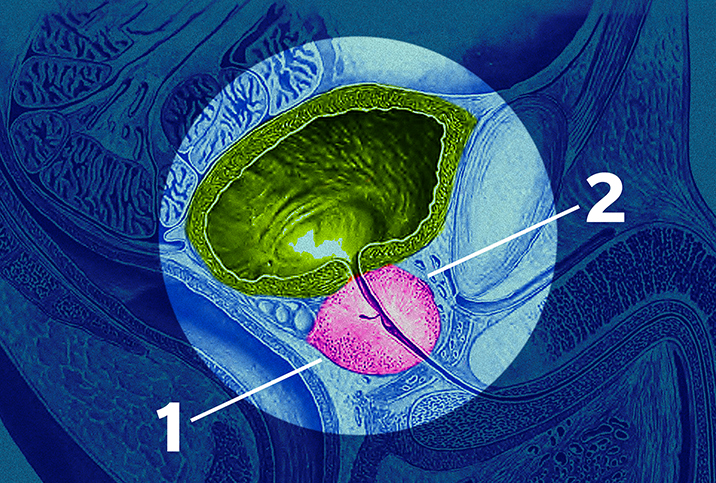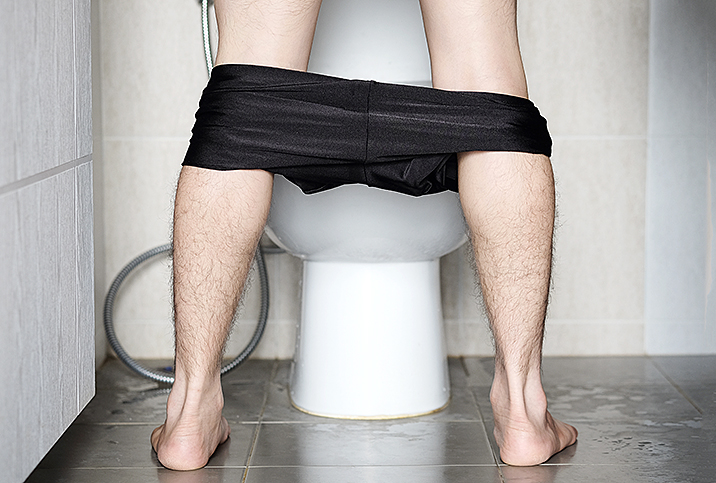Your Penis Isn't a Shield Against Urinary Tract Infections

Do you feel pain or a burning sensation when you urinate? If so, you could have a urinary tract infection (UTI). But I'm a man, you say, only women get those. That's a misconception. About 12 percent of men experience at least one UTI during their lifetime, according to the American Urological Association (AUA).
UTIs involve the urinary system, the parts of the body that produce urine and transport it out of the body. UTIs can involve any part of the urinary system—the urethra, ureters, bladder and kidneys—and are typically classified as either lower tract infections or upper tract infections.
Lower tract infections include the bladder and urethra. Upper tract infections involve the ureters and kidneys, and usually occur because bacteria have either traveled from the bladder to the kidney or been carried via the bloodstream and collected in the kidney.
In young men, sexual activity or a sexually transmitted infection (STI) are common causes of a UTI, according to Seth Cohen, M.D., an assistant professor of urology and the director of sexual medicine at New York University Langone Health.
UTIs are more common in men older than 50, and in their case, it's more likely to be a prostate-related issue. Benign prostatic hyperplasia (BPH), an age-related enlargement of the prostate, not fully emptying the bladder and urine retention can cause a UTI in older men, Cohen said. Kidney stones and bladder stones may lead to a UTI. Fortunately, such infections are highly treatable with antibiotics.
UTI symptoms and diagnosis
Common symptoms of a UTI in men include: an increased frequency of urination; a constant urge to urinate; dysuria, or burning and pain with urination; hematuria, or blood in the urine; foul-smelling urine; cloudy, pink, red or brownish urine; a feeling of pressure in the suprapubic (lower abdominal) region; and fever and nausea.
Given all of the urinary symptoms associated with a UTI, it's little surprise someone is diagnosed by performing a urinalysis (urine test) on a sample they provide. The urine is analyzed under a microscope for bacteria or white blood cells.
The urinalysis may be followed by a urine culture, in which bacteria are grown in a lab. This identifies the bacteria causing the infection, as well as the type of antibiotic needed to treat it.
For men with a history of kidney stones, diabetes or polycystic kidneys (a disorder in which cysts develop in the kidneys), the doctor may require imaging exams.
Treatment for UTIs
After the tests have enabled the doctor to choose the right antibiotic—Bactrim, Cipro and Macrobid are common—an appropriate course is determined. Depending on the type and severity of the infection, the antibiotic course could be as little as three to five days or up to two weeks.
Some men feel better within a day or two and may believe the infection is gone and they can stop the antibiotics, but it's important to complete the entire course, according to Laurence Levine, M.D., a professor of urology at Rush University Medical Center in Chicago.
Cohen said urologists don't just give antibiotics to everyone. They want to make sure the urinalysis is positive for a UTI.
"Even though they may have really bad symptoms, it doesn't always mean that they have a UTI," Cohen said. "They could have something like prostatitis or urethritis, which is more inflammatory than infectious. Sometimes they get misdiagnosed and get treated with antibiotics, as well, even though it's not a true infection. [UTI is] really more of an infectious etiology."
If a UTI is not treated, it could potentially lead to significant health problems. Complications are more likely when the patient has a compromised immune system. Serious effects of a UTI include sepsis, a life-threatening whole-body infection, and pyelonephritis, an infection of the kidneys.
Risk factors and prevention
Common risk factors for UTIs in men include STIs (e.g., gonorrhea, chlamydia), prostate enlargement, urinary tract stones, previous UTIs, urethral stricture (blockage of the urethra), diabetes, prior kidney transplant, being uncircumcised, having anal sex, immune system problems, cancer of the urinary tract, and using a urinary catheter for an extended period.
One of the best prevention methods is to stay well hydrated, which keeps the urine diluted so you can flush out any bacteria that might accumulate, Levine said. He added that drinking four to six glasses of water a day is best. If the patient has recurrent UTIs or kidney stones, that recommendation jumps to six to eight glasses per day.
When you feel the urge to urinate, do it. Holding it in could potentially lead to a collection of bacteria in the bladder or urinary tract.
One question many people have is whether UTIs are transmissible to a partner.
"For the most part, I don't believe that's the case," Cohen said. "If it's an STI, then yes, of course. STIs just by the name, sexually transmitted infections, are easy to transmit. But if a woman has [a UTI], it's unlikely to be passed on to the man and vice versa."
Why UTIs are much less common in men than in women
About 60 percent of women get a UTI in their lifetime, according to the AUA. The fact women get them more frequently is "one of those conundrums," Cohen said. It likely comes down to anatomy. A woman's urethra is shorter than a man's, meaning the distance from the bladder to the outside world is much shorter, so there's a greater opportunity for bacteria to work their way back into the bladder.
"It could also be certain host factors," Cohen said. "And there are things called villi, and those villi have different binding factors. Women may have more of those that can bind onto bacteria and hold on to bacteria and make them more susceptible to having UTIs. But for the most part, we believe it's an anatomical thing."
There has been some association between UTIs and sexual activity, Levine said. Bacteria within the urethra may get pushed back into the bladder during penis-in-vagina intercourse. This could happen to any woman, but especially a woman who is having sex for the first time or for the first time in a long time.
For adult men, a common reason for UTIs is incomplete bladder-emptying, which may be due to a case of BPH causing a greater resistance at the neck of the bladder that doesn't allow all of the urine to be pushed out, Levine said.
"Urine remains behind, and what I call it is a stagnant pond," he said. "The bacteria is always there and has an opportunity to proliferate because they're not being flushed out with each void, and so they can get a handhold and then, bingo, an infection occurs."
If a man has a bladder stone or kidney stone, the bacteria can hide out in the stone.
"The antibiotic kills all the bacteria on the surface and floating around the urine, but if there are bacteria inside the stone, they just hide out until the antibiotic is gone and they come out, oftentimes stronger," Levine said.
Men shouldn't assume they can't get a urinary tract infection. If the symptoms are there, they should get checked.
"If they do have a UTI, they need to determine what's the cause so they can correct that and not have it again," Levine said. "In an older individual who might have other comorbidities, a UTI can be a lot more threatening than just a simple urinary tract infection; it can really make them sick."


















